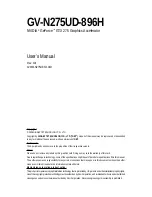
If you cannot obtain a reasonably stable DC voltage measurement between the grounds, or the voltage
drifts around considerably, the two grounds are most likely isolated. The easiest way to check for
isolation is to change your voltmeter to it’s ohm scale and measure the resistance between the two
grounds. It is recommended that you turn both systems off prior to taking this resistance measurement. If
the measured resistance is more than 100 Kohm, it’s a fairly safe bet that your system has electrically
isolated grounds.
Systems with Common Grounds
In the simplest (but perhaps least likely) case, your signal source will have the same ground as the
PCIM-DAS1602/16. This would typically occur when providing power or excitation to your signal
source directly from the PCIM-DAS1602/16. There may be other common ground configurations, but it
is important to note that any voltage between the PCIM-DAS1602/16 ground and your signal ground is a
potential error voltage if you set up your system based on a common ground assumption.
As a safe rule of thumb, if your signal source or sensor is not connected directly to an LLGND pin on
your PCIM-DAS1602/16, it’s best to assume that you do not have a common ground even if your
voltmeter measured 0.0 Volts. Configure your system as if there is ground offset voltage between the
source and the PCIM-DAS1602/16. This is especially true if you are using the PCIM-DAS1602/16 at
high gains since ground potentials in the sub-millivolt range will be large enough to cause A/D errors, yet
will not likely be measured by your hand-held voltmeter.
Systems with Common Mode (ground offset) Voltages
The most frequently encountered grounding scenario involves grounds that are somehow connected, but
have AC and/or DC offset voltages between the PCIM-DAS1602/16 and signal source grounds. This
offset voltage may be AC, DC or both and can be caused by a wide array of phenomena including EMI
pickup, resistive voltage drops in ground wiring and connections, etc. Ground offset voltage is a more
appropriate term to describe this type of system, but since our goal is to keep things simple, and help you
make appropriate connections, we’ll stick with our somewhat loose usage of the phrase Common Mode.
Small Common Mode Voltages
If the voltage between the signal source ground and PCIM-DAS1602/16 ground is small, the combination
of the ground voltage and input signal will not exceed the +/-10V common mode range, (i.e. the voltage
between grounds, added to the maximum input voltage, stays /-10V), This input is compatible
with the PCIM-DAS1602/16 and the system can be connected without additional signal conditioning.
Fortunately, most systems will fall in this category and have a small voltage differential between
grounds.
Large Common Mode Voltages
If the ground differential is large enough, the +/- 10V common mode range can be exceeded. (If the
voltage between the card and signal source ground, plus the maximum input voltage you’re trying to
measure, if this e/-10V, you’ll exceed the maximum CMR.) In this case the PCIM-DAS1602/16
cannot be directly connected to the signal source. You will need to change your system grounding
configuration or add isolation signal conditioning. (Please look at our ISO-RACK and ISO-5B-series
products to add electrical isolation, or give our technical support group a call to discuss other options.)
13
Содержание PCIM-DAS1602/16
Страница 4: ...This page is blank ...
Страница 48: ...For your notes 44 ...
















































